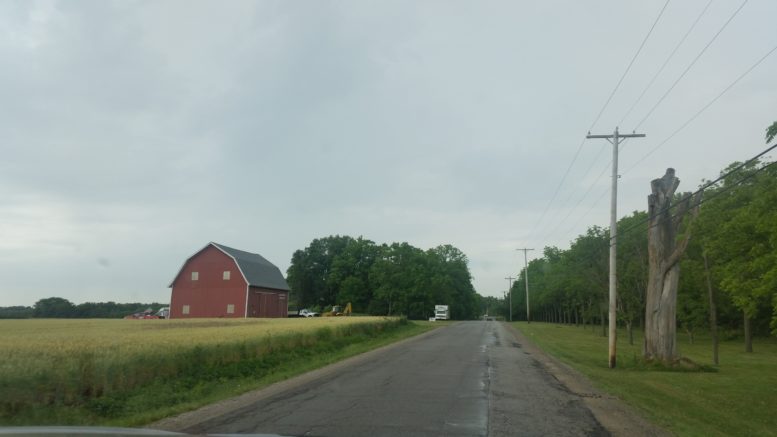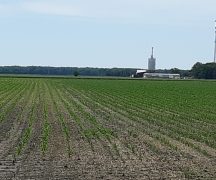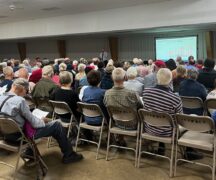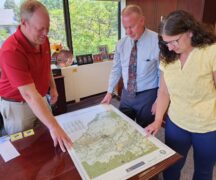By JAN LARSON McLAUGHLIN
BG Independent News
After years of watching their taxes valuations grow like weeds, local farmers are now seeing their property taxes drop. While that is good news for farmers, it’s shifted some of the tax burden to homeowners.
Every six years, state mandated full reappraisals are done on all properties in the county. Updates are conducted every three years. Later this month, the Wood County Auditor’s Office will send out notices of the new valuations to local farmers.
Prior to 1974, farmers were taxed based on the market value of their land – that’s how much it would sell for, explained Wood County Auditor Matt Oestreich. So 40 acres of farmland on the edge of Perrysburg would be taxed at a much higher rate than 40 acres outside of Bloomdale.
That created a lot of pressure on some farmers to sell their land because they couldn’t afford the property taxes.
“Farmers were being taxed off their land,” Oestreich said.
So the state changed its formula, and started setting valuations based on the amount that could be produced on the acreage. In Wood County, that covers approximately 380,000 acres – with about 81 percent of the county’s total acreage used for agriculture.
“The income potential is the same,” per bushel of corn in Perrysburg Township as it is in Bloom Township, said Brian Jones, the Current Agricultural Use Valuation specialist in the Wood County Auditor’s Office.
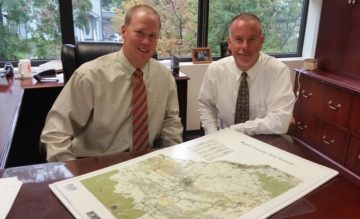
Wood County Auditor Matt Oestreich and CAUV specialist Brian Jones look at ag map of Wood County.
Factored into the valuation are the different soils, with Wood County having about 200 different soil types. Nearly two-thirds of county farmland is Hoytville clay, which is just above average soil quality for farming, Jones said.
The CAUV formula worked in favor of the farmers in 2005, when the lowest values in the history of the program were appraised. Farmland was “dirt cheap,” and farmers got the benefit of lower taxes.
When the 2008 updates rolled around, the values had doubled. Agricultural land valued at $350 an acre jumped up to about $780 an acre. The tax rates went from $4 to $8 an acre, which was still quite low, so few farmers complained, Oestreich and Jones explained.
“It was fueled by good yields, high crop prices and increasingly low interest rates,” Oestreich said. “It was a perfect storm of sorts.”
In 2011, the values doubled again, with some farmland at $1,770 an acre and taxes up to $25 an acre.
“That’s when we really started to get pushback,” Jones said.
“That opened a lot of people’s eyes,” Oestreich said. “Imagine if the value of your house went from $150,000 to $300,000” in a three-year period. “That’s a tough pill for farmers to swallow.”
Several farmers accused the government of raising the valuations in order to collect more taxes.
A meeting was held to explain the increases to local farmers. More than 500 showed up. The farm bureau and the county auditor’s office explained the valuations were calculated by the state, and that market value was not part of the equation.
The CAUV formula takes into consideration crop rotation, yields, crop prices, production costs (such as gas, fertilizer, labor) and interest rates.
Then it happened again in 2014, when the farmland valuations more than doubled from an average of $1,770 to $3,930 an acre. That meant the taxes grew from about $35 to $80 an acre. The jump was brought on by good crop yields, increased prices for crops, and interest rates going down.
“Obviously, that was a huge blow,” Oestreich said.
Another meeting was held with local farmers, again with hundreds attending.
Then, finally, this year the farmers got a little relief. “We’ve started to see them come down,” Jones said of the updated valuations. For example, Hoytville clay soil values dropped from $3,930 to $3,110 an acre. Of course that 20 percent slide occurred partially due to lower crop prices.
The state made changes in 2015 that allowed the values to come down faster and not be so slow to react to the trends. “The values were going to come down anyways. It quickened the reduction,” Jones said.
This year, the state made a change to put conservation land at the lowest soil value. That could affect tens of thousands of acres in Wood County, Jones said.
“That is huge for some farmers,” Oestreich said. “It’s a significant reduction.”
The county auditor’s office has been getting a lot of calls from farmers wanting to find out how much the 6-mill school bond issue for Bowling Green City Schools will cost them. Jones said it would have cost them about $6.50 per acre for the levy, but with the CAUV drop and the conservation change, farmers will probably be paying less than that, he added.
Of course, when farmland values drop, then residential owners see their valuations go up.
“It has to balance out,” Oestreich said.
“Anytime one goes up or down, the other has to change. The burden is shifted,” Jones said.
Levy millage passed by voters has to generate a certain amount. Whether it comes from farm or residential taxes, “that same amount needs to be collected,” Jones said.
So after years of farm values rising, now residential values are going up, by about 9 percent. However, Oestreich and Jones explained that property owners cannot be charged more than the levy millage approved by voters. An owner of a $200,000 home in the Bowling Green City School District would see an annual increase in property taxes of $420 for the school levy.

